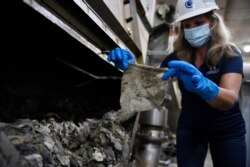Health officials are looking at an unlikely source for early signs of a COVID-19 outbreak in their communities.
Sewage.
Data about the coronavirus found in sewage can warn of an outbreak up to seven days before clinical testing shows signs of a spike, say wastewater epidemiologists. That can give public health workers time to get ready – prepare hospitals, ramp up closures and take other measures.
“You’re seeing it in sewage before people are really showing the symptoms, days and weeks before,” said Eileen White, director of wastewater for EBMUD, a utility that serves 685,000 households in San Francisco’s East Bay area.
Since the pandemic began, the field of wastewater epidemiology, which tracked polio and Ebola viruses, has grown rapidly in response. An international alliance of more than 400 researchers is collaborating to share findings and methods, in an attempt to bring the most accurate information about the disease’s spread to leaders.
Stricken cruise ship’s waste
In early March, the Grand Princess cruise ship, carrying passengers and crew infected with the coronavirus, arrived at the Port of Oakland. White was tasked with managing its sewage.
“They came into the Port of Oakland with a cruise ship full of waste and they needed to get rid of it. And so we effectively treated some of the first coronavirus sewage,” she said.
Her early experience – detecting the virus in order to successfully destroy it – led White to collaborate with other labs seeking to use wastewater to track the spread of the virus.
Gaps left by clinical testing
Testing individuals on a scale necessary to control the virus has been hampered for many reasons, including scarcity of test kits, lack of access to health care and fear. Another issue with testing: People can have the disease for days without displaying symptoms and feeling the need to be tested.
Those early days are critical because an asymptomatic person could spread the disease widely without knowing it.
Wastewater testing can provide a more complete picture than clinical testing alone, White and other researchers said. It not only represents everyone who uses a toilet, but COVID-19 is detectable in the stool of asymptomatic people.
White’s team at EBMUD is collecting and analyzing samples each week, as well as sending them to other labs to compare results. One of those is the Nelson Lab at the University of California, Berkeley.
Getting useful data from raw sewage has many challenges, Lauren Kennedy, a researcher at the lab, said.
“There’s a lot of things that make wastewater complicated, right?” Kennedy said. “It's not just poop and pee in wastewater. It's also rainwater and laundry water and things that vary with time. And so that will affect how dilute the virus is in the sample, like how much we can detect.”
It’s a challenge that an international community of researchers has taken on.
“We're seeing people from all over the world interacting,” Dr. Rose Kantor, project manager at the Nelson Lab, said. “And I think it's really unprecedented in the history of science, because typically what happens is people have a finding and they publish it in a paper and then other scientists read about it. But we're trying to make progress in real time.”
Mobilizing to meet demand
Prior to the pandemic, Massachusetts-based Biobot Analytics was monitoring wastewater samples in communities struggling with high opioid use. When coronavirus hit, the firm switched its focus. Now its lab analyzes samples from 400 utilities in 41 U.S. states.
Dr. Mariana Matus, co-founder and chief executive of Biobot, is confident that the sampling can predict trends.
“Wastewater data that you measure today is giving you an early warning indication of how many new COVID-19 cases you will see in that community about seven days out,” she said. “Wastewater gives you that window of opportunity.”
Matus met her Biobot co-founder, Newsha Ghaeli, at the Massachusetts Institute of Technology. Their start-up uses machine-learning and other modeling technology to analyze their findings.
“Our objective is to make sure that the data is understandable and actionable by nonexperts rather than just reporting what comes out of the lab,” Matus said.
Biobot’s estimates have revealed large discrepancies between confirmed cases in a community and what wastewater can detect – sometimes 10 times the amount. A week later, their projections are often proven correct, Matus said.
“What we have discovered is that when we find that large discrepancy, our data is usually actually forecasting that it's going to be an increase in cases in the next few days,” she said.
Not only is wastewater testing predictive, it is also more equitable, Matus said.
“What better tool to use for public health than wastewater. Every time we are using the toilet, we are basically contributing to that data set. And it doesn't matter if we have access to health care, if we have insurance coverage or if culturally we don't feel super safe to go into the hospital. We still count,” she said.
Kantor, at Berkeley, agreed. “The amount of value that people suddenly see in wastewater, I think it's refreshing to realize that it is the catchment of all of society and we have a way of tracking important diseases, and I think it'll probably be used going well into the future as well.”
The Nelson Lab at Berkeley plans to monitor sewage on their own campus this fall to support the university’s safe reopening.














